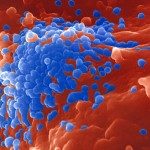Lien vers Pubmed [PMID] – 21242344
Arch Dermatol 2011 May;147(5):590-6
BACKGROUND: Skin eruptions resembling epidermodysplasia verruciformis (EV) are rarely observed in immunocompromised patients. We focused on the epidemiologic, clinical, virologic, and immunologic features of EV in human immunodeficiency virus (HIV)-positive patients.
OBSERVATIONS: We studied 11 HIV-positive patients (6 men and 5 women) with clinical and histological features of EV observed at our department. The median age at HIV diagnosis was 27 years. At the onset of eruption, the median age was 40 years and the median CD4 T-cell count was 170/μL. Clinical presentation included flat warts (n = 11), pityriasis versicolor-like macules (n = 5), and lichenoid papules (n = 3) on sun-exposed skin. Detection and typing of cutaneous human papillomavirus (HPV) were carried out in 8 cases and always revealed β-HPV infection, including oncogenic HPV-5 or 8 (n = 6). Mucosal HPV-related diseases were present in 7 cases. Histories of skin cancer and lymphoproliferative disorder were recorded in 3 and 4 patients, respectively, including 2 fatal cases. Skin eruption was never improved by highly active antiretroviral therapy (HAART). In 2 cases, EV was associated with an immune reconstitution syndrome. The present series is the largest with a complete characterization. A review of similar cases was carried out.
CONCLUSION: Despite effective HAART, HIV-infected patients with EV require a prolonged and careful follow-up to detect mucosal HPV-related diseases, lymphoproliferative disorders, and skin cancers.

